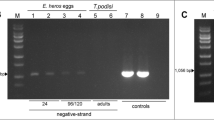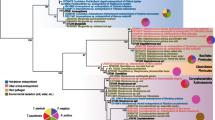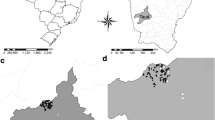Abstract
Triatoma virus (TrV) is a small, non-enveloped virus that has a +ssRNA genome and is currently classified under the Cripavirus genus of the Dicistroviridae family. TrV infects haematophagous triatomine insects (Hemiptera: Reduviidae), which are vectors of American trypanosomosis (Chagas disease). TrV can be transmitted through the horizontal faecal-oral route, and causes either deleterious sublethal effects or even the death of laboratory insect colonies. Various species of triatomines from different regions of Latin America are currently being reared in research laboratories, with little or no awareness of the presence of TrV; therefore, any biological conclusion drawn from experiments on insects infected with this virus is inherently affected by the side effects of its infection. In this study, we developed a mathematical model to estimate the sample size required for detecting a TrV infection. We applied this model to screen the infection in the faeces of triatomines belonging to insectaries from 13 Latin American countries, carrying out the identification of TrV by using RT-PCR. TrV was detected in samples coming from Argentina, which is where the virus was first isolated from Triatoma infestans (Hemiptera: Reduviidae) several years ago. Interestingly, several colonies from Brazil were also found infected with the virus. This positive result widens the TrV’s host range to a total of 14 triatomine species. Our findings suggest that many triatomine species distributed over a large region of South America may be naturally infected with TrV.
Similar content being viewed by others
References
Baines S. (1956) The role of the symbiotic bacteria in the nutrition of Rhodnius prolixus (Hemiptera). Journal of Experimental Biology 33, 533–541.
Bonning B. C. and Miller W. A. (2010) Dicistroviruses. Annual Review of Entomology 55, 129–150.
Dolder H. and Mello M. L. S. (1978a) Dados preliminares sobre partículas semelhantes a virus em celulas de triatomineos. Revista de Saude Publica 12, 104–109.
Dolder H. and Mello M. L. S. (1978b) Virus like particles in the Malpighian tubes of blood-sucking hemipterans. Cellular and Molecular Biology 23, 299–310.
Espino C. I., Gómez T., González G., Brazil do Santos M. R., Solano J., Sousa O., Moreno N., Windsor D., Ying A., Vilchez S. and Osuna A. (2009) Detection of Wolbachia bacteria in multiple organs and feces of the triatomine insect Rhodnius pallescens (Hemiptera, Reduviidae). Applied and Environmental Microbiology 75, 547–550.
Fernandes A. J., da Silva J. C. and Diotaiuti L. (1990) Natural parasitism of triatominae eggs by Telenomus fariai Lima, 1927 in the laboratory. Revista da Sociedade Brasileira de Medicina Tropical 23, 149–151.
González N. L. (2008) Determinación del efecto de la infección con Triatoma virus en diferentes espécies de triatominos. Tesis de maestría, Universidad de los Andes, Bogotá, Colombia.
Gordon K. H. J. and Waterhouse P. M. (2006) Small RNA viruses of insects: expression in plants and RNA silencing, Vol. 68, pp. 459–502. In Insect Viruses: Biotechnological Applications (edited by B. C. Bonning, K. Maramorosch and A. J. Shatkin). Advances in Virus Research Series. Elsevier, San Diego.
ICTVdB (2002) Index of viruses. Available at: https://doi.org/www.ncbi.nlm.nih.gov/ICTVdb/Ictv/fs_dicis
Marti G. A., Echeverria M. G., Susevich M. L., Becnel J. J., Pelizza S. A. and García J. J. (2009) Prevalence and distribution of parasites and pathogens of Triatominae from Argentina, with emphasis on Triatoma infestans and Triatoma virus TrV. Journal of Invertebrate Pathology 102, 233–237.
Marti G. A., Gonzalez E. T., García J. J., Viguera A. R., Guérin D. M. A. and Echeverria M. G. (2008) AC-ELISA and RT-PCR assays for the diagnosis of Triatoma virus (TrV) in triatomines (Hemiptera: Reduviidae) species. Archives of Virology 153, 1427–1432.
The Mathworks (2011) MATLAB software, Version 7.
Muscio O. A. (1988) Búsqueda de entompatógenos y su evaluación como posibles agentes de control de Triatoma infestans. PhD thesis, Universidad Nacional de La Plata, La Plata, Argentina.
Muscio O. A., Bonder M. A., La Torre J. L. and Scodeller E. A. (2000) Horizontal transmission of Triatoma virus through the fecal-oral route in Triatoma infestans (Hemiptera: Triatomidae). Journal of Medical Entomology 37, 271–275.
Muscio O. A., La Torre J. L., Bonder M. A. and Scodeller E. A. (1997) Triatoma virus pathogenicity in laboratory colonies of Triatoma infestans (Hemiptera: Reduviidae). Journal of Medical Entomology 34, 253–256.
Muscio O. A., La Torre J. L. and Scodeller E. A. (1988) Characterization of Triatoma virus, a Picorna-like virus isolated from the Triatomine bug Triatoma infestans. Journal of General Virology 69, 2929–2934.
Muscio O. A., La Torre J. L. and Scodeller E. A. (1987) Small nonoccluded viruses from triatomine bug Triatoma infestans (Hemiptera: Reduviidae). Journal of Invertebrate Pathology 49, 218–220.
Petherick A. (2010) Chagas disease outlook: country by country. Nature 465, S10–S11. doi:10.1038/nature09223. Available at: https://doi.org/www.nature.com/outlooks
Querido J. F. B., Agirre J., Marti G. A., Guérin D. M. A. and Sousa Silva M. (2013a) Inoculation of Triatoma virus (Dicistroviridae: Cripavirus) elicits a non-infective immune response in mice. Parasites and Vectors 6, 66. doi:10.1186/1756-3305-6-66.
Querido J. F. B., Agirre J., Marti G. A., Guérin D. M. A. and Sousa Silva M. (2013b) Molecular techniques for dicistrovirus detection without RNA extraction or purification. BioMed Research International, Article ID 218593, 3 pages. doi:10.1155/2013/218593.
Rabinovich J. (2012) Free access bibliographic database on triatomines and Chagas disease. WebBibTri v3.0. Available at: https://doi.org/bibtri.com.ar
Rozas-Dennis G. S. and Cazzaniga N. J. (1997) Triatominos de Bahía Blanca: respuestas biológicas a la infección con un Picornavirus. Medicina 57, 85–91.
Rozas-Dennis G. S. and Cazzaniga N. J. (2000) Effect of Triatoma virus (TrV) on fecundity and moulting in Triatoma infestans (Hemiptera: Reduviidae). Tropical Medicine and Parasitology 94, 633–641.
Rozas-Dennis G. S., Cazzaniga N. J. and Guérin D. M. A. (2002) Triatoma patagonica (Hemiptera: Reduviidae), a new host for Triatoma virus. Memorias do Instituto Oswaldo Cruz 97, 427–429.
Rozas-Dennis G. S., La Torre J.-L., Muscio O. A. and Guérin D. M. A. (2000) Direct methods for detecting picornalike virus from dead and alive triatomine insects. Memorias do Instituto Oswaldo Cruz 95, 323–327.
Ryckman R. (1951) Recent observations of cannibalism in Triatoma (Hemiptera: Reduviidae). Journal of Parasitology 37, 433–434.
Schaub G. A., Böker C. A., Jensen C. and Reduth D. (1989) Cannibalism and coprophagy are modes of transmission of Blastocrithidia triatomae (Trypanosomatidae) between triatomines. Journal of Protozoology 36, 171–175.
Susevich M. L., Marti G, Serena M. S. and Echeverria M. G (2012) New Triatoma virus hosts in wild habitats of Argentina. Journal of Invertebrate Pathology 110, 405–407.
Author information
Authors and Affiliations
Corresponding author
Additional information
This work was conceived during a plenary meeting of the RedTrV consortium (https://doi.org/www.redtrv.org) in Balmaseda, Spain, 19–21 September 2010. A full list of authors is available in Appendix 2.
Rights and permissions
About this article
Cite this article
Marti, G.A., Echeverría, M.G., Susevich, M.L. et al. Exploration for Triatoma virus (TrV) infection in laboratory-reared triatomines of Latin America: a collaborative study. Int J Trop Insect Sci 33, 294–304 (2013). https://doi.org/10.1017/S1742758413000337
Accepted:
Published:
Issue Date:
DOI: https://doi.org/10.1017/S1742758413000337




